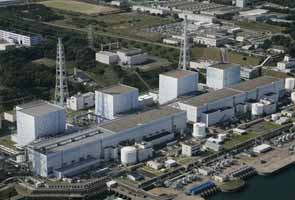Washington: The first readings from American data-collection flights over the stricken Fukushima Daiichi nuclear plant in Japan show that the worst contamination has not spread beyond the 19-mile range of highest concern established by Japanese authorities.
But another day of frantic efforts to cool nuclear fuel in the stricken reactors and the plant's spent-fuel pools resulted in little or no progress, according to United States government officials.
Japanese officials said they would continue those efforts, but were also racing to restore electric power to the site to get equipment going again, leaving open the question of why that effort did not begin days ago, at the first signs that the critical backup cooling systems for the reactors had failed.
The data was collected by the Aerial Measurement System, among the most sophisticated devices rushed to Japan by the Obama administration in an effort to help contain a nuclear crisis that a top American nuclear official said Thursday could go on for weeks. Strapped onto a plane and a helicopter that the United States flew over the site, with Japanese permission, the equipment took measurements that showed harmful radiation in the immediate vicinity of the plant -- a much heavier dose than the trace levels of radioactive particles that make up the atmospheric plume covering a much wider area.
While the findings were reassuring in the short term, the United States declined to back away from its warning to Americans to stay at least 50 miles from the plant, setting up a far larger perimeter than the Japanese government had established.
American officials said their biggest worry was that a frenetic series of efforts by the Japanese military to get water into some of the plant's six reactors -- including water cannons and fire fighting helicopters that dropped water but appeared to largely miss their targets -- showed few signs of working.
"This is something that will likely take some time to work through, possibly weeks, as eventually you remove the majority of the heat from the reactors and then the spent fuel pool," said Gregory Jaczko, the chairman of the United States Nuclear Regulatory Commission, briefing reporters at the White House. "So it's something that will be on-going for some time."
The effort by the Japanese to hook electric power back up to the plant did not begin until Thursday and was likely to take several days to complete -- and even then it was unclear how the cooling systems, in reactor buildings battered by a tsunami and then torn apart by hydrogen explosions, would help end the crisis.
"What you are seeing are desperate efforts -- just throwing everything at it in hopes something will work," said one American official with long nuclear experience who would not speak for attribution. "Right now this is more prayer than plan."
After a day in which American and Japanese officials gave radically different assessments of the danger from the nuclear plant, the two governments tried on Thursday to join forces.
Experts met in Tokyo to compare notes. The United States, with Japanese permission, began to put the intelligence-collection aircraft over the site, in hopes of gaining a view for Washington as well as its allies in Tokyo that did not rely on the announcements of officials from the Tokyo Electric Power Company, which operates Fukushima Daiichi.
American officials say they suspect that the company has consistently underestimated the risk and moved too slowly to contain the damage.
Aircraft normally used to monitor North Korea's nuclear weapons activities -- a Global Hawk drone and U-2 spy planes -- were flying missions over the reactor, trying to help the Japanese government map out its response to the last week's 9.0-magnitude earthquake, the tsunami that followed and now the nuclear disaster.
President Obama made an unscheduled stop at the Japanese Embassy to sign a condolence book, writing, "My heart goes out to the people of Japan during this enormous tragedy." He added, "Because of the strength and wisdom of its people, we know that Japan will recover, and indeed will emerge stronger than ever."
Later he appeared in the Rose Garden at the White House to offer continued American support for the earthquake and tsunami victims, and technical help at the nuclear site.
But before the recovery can begin, the nuclear plant must be brought under control. So American officials were fixated on the temperature readings inside the three reactors that had been operating until the earthquake shut them down, and at the spent fuel pools, looking for any signs that their high levels of heat were going down. If they are uncovered and exposed to air, the fuel rods in those pools heat up and can burst into flame, spewing radioactive elements.
So far they saw no signs of dropping temperatures. And the Web site of the International Atomic Energy Agency, the United Nations nuclear watchdog made it clear that there were no readings at all from some critical areas. Part of the American effort, by satellites and aircraft, is to identify the hot spots, something the Japanese have not been able to do in some cases.
Critical to that effort are the "pods" flown into Japan by the Air Force over the past day. Made for quick assessments of radiation emergencies, the Aerial Measuring System is an instrument system that fits on a helicopter or fixed-wing aircraft to sample air and survey the land below. The information is used to produce coloured maps of radiation exposure and contamination.
Daniel B. Poneman, the deputy secretary of energy, said at a White House briefing on Thursday that one instrument pod was mounted on a helicopter, and the other on a fixed-wing aircraft.
"We flew those aircraft on their first missions," he said. The preliminary results, he added, "are consistent with the recommendations that came down from the chairman of the Nuclear Regulatory Commission," which led to the 50-mile evacuation guideline given to American expatriates. "So the indications are that that looks like it was a prudent move," Mr. Poneman said.
The State Department has also said it would fly out of the country any dependents of American diplomats or military personnel within the region of the plant and as far south as Tokyo. Space will be made for other Americans who cannot get a flight, it said.
Getting the Japanese to accept the American detection equipment was a delicate diplomatic manoeuvre, which some Japanese officials originally resisted. But as it became clear that conditions at the plant were spinning out of control, and with Japanese officials admitting they had little hard evidence about whether there was water in the cooling pools or breaches in the reactor containment structures, they began to accept more help.
The sensors on the instrument pod are good at mapping radioactive isotopes, like Cesium-137, which has been detected around the stricken Japanese complex and has a half-life of 30 years. Its radiation can alter cellular function, leading to an increased risk of cancer.
Cesium-137 mixes easily with water and is chemically similar to potassium. It thus mimics the way potassium gets metabolized in the body and can enter through many foods, including milk.
On Wednesday when the American Embassy in Tokyo, on advice from the Nuclear Regulatory Commission, told Americans to evacuate a radius of "approximately 50 miles" from the Fukushima plant, the recommendation was based on a specific calculation of risk of radioactive fallout in the affected area.
In a statement, the commission said the advice grew out of its assessment that projected radiation doses within the evacuation zone might exceed one rem to the body or five rems to the thyroid gland. That organ is extremely sensitive to Iodine-131 -- another of the deadly by-products of nuclear fuel, this one causing thyroid cancer.
A rem is a standard measure of radiation dose. The commission says that the average American is exposed to about 0.62 rem of radiation each year from natural and manmade sources.
The American-provided instruments in Japan measure real levels of radiation on the ground. In contrast, scientists around the world have also begun to draw up forecasts of how the prevailing winds pick up the Japanese radioactive material and carry it over the Pacific in invisible plumes.
The former are actual measurements, whereas the latter are projections based mostly on predicted weather patterns.
Private analysts said the United States was also probably monitoring the reactor crisis with a flotilla of spy satellites that can see small objects on the ground as well as spot the heat from fires -- helping it independently assess the state of the reactor complex from a distance.
Jeffrey G. Lewis, an intelligence specialist at the Monterey Institute, a research centre, noted that the Japanese assessment of Reactor No. 4 at the Daiichi complex seemed to depend in part on visual surveillance by helicopter pilots.
"I've got to think that, if we put our best assets into answering that question, we can do better," he said in an interview.
One of the particular concerns at No. 4 has been a fire that was burning there earlier in the week, but American officials are not convinced that the fire has gone out.
Even the weather satellites used by the Defence Department have special sensors that can monitor fires. Experts said their detectors are sensitive enough to detect smouldering fires underground -- suggesting they might also be able to see radioactive fires inside the stricken reactors.
The No. 4 reactor has been of particular concern to American officials because they believe the spent fuel pool there has run dry, exposing the rods.











 Click to Expand & Play
Click to Expand & Play


